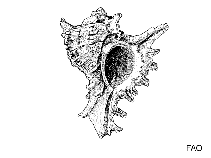Rapana venosa (Valenciennes, 1846)
Purple whelk| Native range | All suitable habitat | Point map | Year 2050 |

|
| This map was computer-generated and has not yet been reviewed. |
| Rapana venosa AquaMaps Data sources: GBIF OBIS |
Google image | No image available for this species;
drawing shows typical species in Muricidae.
Classification / Names Common names | Synonyms | CoL | ITIS | WoRMS
Gastropoda | Neogastropoda | Muricidae
Environment: milieu / climate zone / depth range / distribution range Ecology
Benthic; brackish; depth range 10 - 60 m (Ref. 83435). Tropical; 4°C - 35°C (Ref. 88058); 41°N - 16°N, 53°E - 143°E
Distribution Countries | FAO areas | Ecosystems | Occurrences | Introductions
Indo-West Pacific. Introduced in the Atlantic, the Mediterranean and Black Sea.
Length at first maturity / Size / Weight / Age
Maturity: Lm ? range ? - ? cm Max length : 16.1 cm SHH male/unsexed; (Ref. 83435)
Short description Morphology
Life cycle and mating behavior Maturity | Reproduction | Spawning | Eggs | Fecundity | Larvae
Main reference
References | Coordinator | Collaborators
Tan, K.S. 2000 Species checklist of Muricidae (Mollusca: Gastropoda) in the South China Sea. The Raffles Bulletin of Zoology 8:495-512. (Ref. 81755)
IUCN Red List Status
(Ref. 130435: Version 2025-1)
CITES status (Ref. 108899)
CMS (Ref. 116361)
Threat to humans
Human uses
Fisheries: commercial
| FishSource | Sea Around Us
Tools
More information
Max. ages / sizes
Length-weight rel.
Length-length rel.
Length-frequencies
Mass conversion
Abundance
Internet sources
BHL | BOLD Systems | CISTI | DiscoverLife | FAO(Publication : search) | Fishipedia | GenBank (genome, nucleotide) | GloBI | Gomexsi | Google Books | Google Scholar | Google | PubMed | Tree of Life | Wikipedia (Go, Search) | Zoological Record



